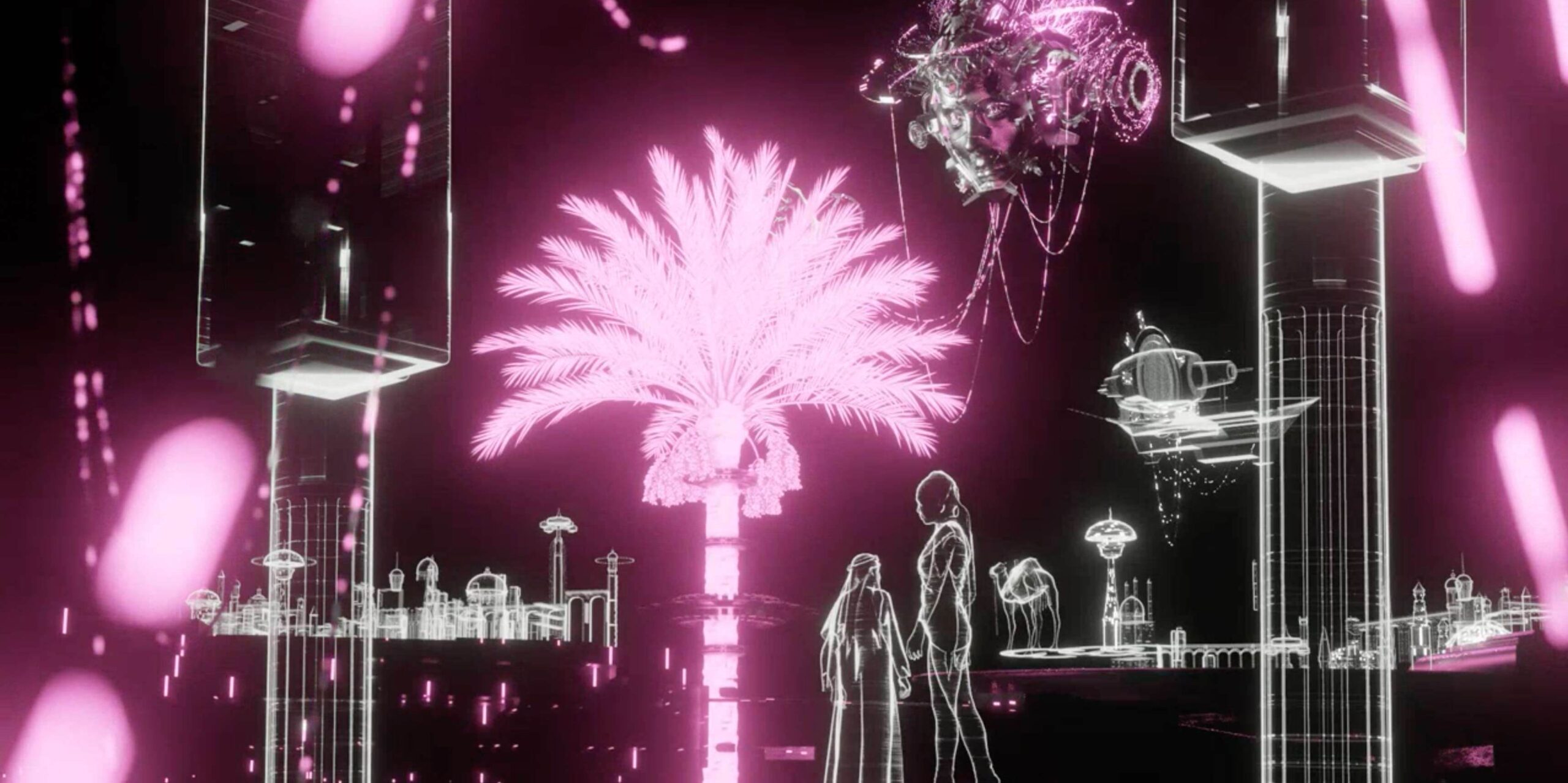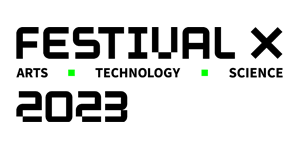In the exhibition From the Past We Love, to the Future We Need, we encounter not only a new art form but also artworks that address the major challenging questions of our time and offer alternative, prototypical solutions beyond mere criticism. Sustainability, coexistence, and collaboration will be defining concepts, as well as the role we, as humans, assume and the role we want to assign to technology.
Type: Exhibition
Duration: October 6 – 8, 2023
City, Country: Dubai, United Arab Emirates
Venue: Festival X, Alserkai Avenue, 17th StreetAl Quoz Industrial Area 1, Dubai UAE
The United Arab Emirates (UAE) is characterized by cultural diversity, where tradition and modernity as well as regional circumstances and global dynamics intersect in a unique way. These circumstances have led to an ecosystem in which people and their culture, tools, and relationship with nature form a unique connection. This relationship is the result of specific existential conditions and has created a logical connection between tradition, innovation, and vision that is not evident in the same way in other parts of the world. The ability to defy and adapt to circumstances has become an everyday routine and an important part of the cultural identity.
This raises the question of how this complex life situation can be artistically reflected and what artistic forms of expressions and tools can emerge from it. Ars Electronica and Festival X have joined forces to explore this question and find answers through local and international artistic perspectives. The contemporary art form of media art, which engages with a society shaped by new technologies and the associated risks and opportunities, is presented. Media artists use these very technologies as tools for innovative artistic expression.
The common goal of Ars Electronica and Festival X is to promote a local artistic community through this new art form. Inspired by the dynamics of the region’s unique circumstances, a distinct dialectic of media art will emerge. A new perspective on art and artists is intended to strengthen identity within the region and build a direct bridge between tradition and modernity through innovative forms of expression. Tradition should no longer be solely associated with the past, but rather become a concept that represents a society’s attitude that is aware of its roots and values, while being open and adaptable to a challenging future.
In the exhibition From the Past We Love, to the Future We Need, we encounter not only a new art form but also artworks that address the major challenging questions of our time and offer alternative, prototypical solutions beyond mere criticism. Sustainability, coexistence, and collaboration will be defining concepts, as well as the role we, as humans, assume and the role we want to assign to technology. It explores where we position ourselves in nature, the significance we give to nature itself, and ultimately how this affects the nature of humans and human existence.
Artworks
Memo Akten (TR)
Waves 2.0: Terra
A new incarnation in an ongoing series of work. The original series “Waves” (2014-), draws upon the well-established history of both artistic and scientific study on oceans and oceanic waves. Inspired by the likes of J.M.W Turner, Katsushika Hokusai, Ivan Aivazovsky, and many others, it is a data dramatization of complex ocean simulations, distilled and re-imagined in the form of abstracted visuals and sounds. An ongoing series of studies that investigate the tension and delicate balance between the immense power and incredible fragility of the oceans; simultaneously mighty yet delicate; calming yet terrifying; graceful yet violent; a symbol of fear, danger and death as well as hope, freedom and life. The new series expands this approach to waves beyond the ocean, to other kinds of waves that permeate our lives: sound waves, quantum field waves, social & political waves, and in the case of this particular work – to waves in the crust of the Earth, slow motion waves on geological timescales, mountains.
Memo Akten is a multi-disciplinary artist, musician, and researcher from Istanbul, Turkey, currently based in Los Angeles. He creates Speculative Simulations and Data Dramatizations investigating the intricacies of human-machine entanglements; perception and states of consciousness; and the tensions between ecology, technology, science and spirituality. For more than a decade his work has been exploring Artificial Intelligence, Big Data and our Collective Consciousness as scraped by the Internet, to reflect on the human condition; drawing connections between intelligence in nature, intelligence in machines, perception, consciousness, neuroscience, fundamental physics, ritual and religion.
Finnbogi Pétursson (IS)
Earth
In a water-filled basin, Icelandic artist Pétursson creates interference at 7.8 hertz. The sound, which can be heard and felt, becomes visible in the form of waves on the surface of the water. This 7.8 hertz frequency corresponds to a physical phenomenon named the Schumann Resonance that describes the resonation of the Earth’s electromagnetic field. For Pétursson, this is the frequency of our home planet’s pulse.
Finnbogi Pétursson (*1959 in Reykjavik, Iceland) is one of the leading contemporary artists in Iceland. He creates a bridge between science and nature, examining the very essence of light, sound and energy through sparse installations that utilize one substance to investigate the properties of another. Pétursson refers to himself as a visual artist interested in the behavior of sound, rather than an audio artist. Having grown up playing multiple instruments, it seemed natural for him to combine sound and art. Looking to physics as a source of inspiration, he is drawn to what he calls ‘the in between’–not necessarily the amplifier or the guitar, but what happens to the sound waves between the two, and how you can manipulate it.
Thijs Biersteker in collaboration with UNESCO‘ (NL)
Wither 1M3
The deforestation of the Brazilian Amazon continues at an alarming rate. In an ongoing partnership between the United Nations Educational, Scientific and Cultural Organization (UNESCO) and the artist, Wither is a slice of digital rainforest that disappears at the same rate as the Amazon rainforest. It updates every time new data is available, becoming a living monument to the biodiversity loss happening right now. Every leaf that becomes transparent marks the loss of 128 square meters of rainforest, 641 square meters each second. This confronts us with the urgency of the climate emergency, and the importance of respecting and valuing Earth’s essential living system.
Ecological artist Thijs Biersteker creates interactive awareness installations about the world’s most pressing issues of today. By entangling art and environmental scientific data, he provokes insight into the ecological challenges ahead and what we might learn from them. Collaborating with top scientists and universities he seamlessly weaves together their scientific research with new technologies to create empowering art installations that make big environmental challenges accessible and relatable. Both intellectually and technologically. His immersive installations often described as eco – or awareness art, make the invisible impact we have on the world around us visible.
Ralf Baecker (DE)
Floating Codes
Floating Codes is a site-specific light and sound installation that explores the inner workings and hidden aesthetics of artificial neural networks, the fundamental building blocks of machine learning systems. The exhibition space itself becomes an organism made of light and sound. Due to its open design, it is in constant exchange with its environment and visitors. The network consists of 250 custom-made artificial neurons (informed by McCulloch-Pitts perceptrons and concepts of cellular automata) arranged in a hexagonal topological grid. These neurons can register light stimuli and react by sending out light pulses to communicate with other neurons in the space. Codes and patterns are propagated throughout the network. Signals loop, mutate, feedback, and cancel themselves, resulting in a complex and continuously alternating visual and acoustic movement. The installation places visitors at the center of the artificial neural network’s computational dialog.
Ralf Baecker lives and works in Berlin. His artistic practice is located at the intersections of art, science, and technology. His practice combines algorithmic-generative thinking with a sculptural approach. Baecker’s kinetic and electromechanical installations and machines explore fundamental mechanisms of the digital, cybernetics, artificial neural networks and artificial life. The behavior of his complex and poetic objects oscillates between algorithmic/artificial and organic/ nature-like. As translations and spatializations of digital processes, they allow an alternative look behind the surfaces of contemporary technology and its power structures. His objects are physical realizations of thought experiments that function as subjective epistemological objects, asking fundamental questions about the digital, technology, complexity, and the boundaries between nature and technology.
David Bowen (US)
plant machete
This installation enables a live plant to control a machete. plant machete has a control system that reads and utilizes the electrical noises found in a live philodendron. The system uses an open-source micro-controller connected to the plant to read varying resistance signals across the plant’s leaves. Using custom software, these signals are mapped in real-time to the movements of the joints of the industrial robot holding a machete. In this way, the movements of the machete are determined based on input from the plant. Essentially the plant is the brain of the robot controlling the machete determining how it swings, jabs, slices and interacts in space.
David Bowen is a studio artist and educator whose work has been featured in numerous group and solo exhibitions including ZKM Karlsruhe, Fundación Telefónica Madrid, Eyebeam New York, Ars Electronica Linz, BOZAR Brussels, Science Gallery Dublin, Itau Cultural, São Paulo, Laboral Centro de Arte y Creación Industrial Gijón, The Israel Museum Jerusalem, The Cranbrook Museum of Art Detroit, Intercommunication Center Tokyo and Centre for Contemporary Culture of Barcelona.
Sabrina Ratté (CA)
Objets-monde
Objets-monde explores the impact of human activity on the environment and how it becomes an integral part of our ecosystem. Through the technique of photogrammetry, abandoned objects such as cars and computer screens are captured, resulting in a video collage that incorporates fragments of reality. These objects are then recontextualized in the video, appearing disproportionately large within distant landscapes, resembling the remnants of monumental architecture. The absence of life and the luminous ambiance of the artwork create a juxtaposition between a sense of apocalypse and nostalgia, between the value of the objects and their status as waste, and between an idealized nature and the enduring presence of human traces. These remnants of the Anthropocene era are presented within an interactive installation created in collaboration with Guillaume Arseneault, accompanied by a soundtrack composed by Roger Tellier-Craig.
Sabrina Ratté, a Canadian artist based in Montreal, explores the diverse forms of digital imagery. Her artistic practice encompasses a wide array of mediums, including analog video, 3D animation, photography, printmaking, sculpture, virtual reality, and installation. By continuously incorporating new techniques into her work, she delves into recurring themes that include the influence of architecture and the digital environment on our perception of the world, our relationship with the virtual aspects of existence, and the convergence of technology and the natural world.
Ivan Henriques (BR)
Prototype For a New BioMachine [PNBM]
The Prototype For A New BioMachine (PNBM) is a continuation of the artwork Jurema Action Plant, which aims to empower plants by enabling them to use similar technologies as humans use, and the exploration of the intricate connection between living organisms and machines. The fundamental inquiry revolves around the creation of autopoietic machines, possessing the remarkable ability to maintain a self-organized, autonomous robotic structure while seamlessly integrating living organisms and machines. The ultimate objective of this exploration is to foster the coexistence of an even greater amalgamation of living and non-living systems, fostering a truly symbiotic relationship. By operating on the nanoscale, a concept explored in the PNBM, we tap into the essence of the data acquired from the plant and processed through electronic circuits, manifesting as electron flows. Delving deeper into the realm of nanotechnology will enable us to amplify the energy derived from living organisms, culminating in the interaction with the audience, enabling the robotic structure to move away once the plant’s leaves are touched.
Ivan Henriques is an environmentalist, transdisciplinary artist and researcher working in multimedia installations examining systems. He explores in his works hybrids of living and non-living systems creating novel approaches to investigate endangered and inhospitable ecosystems. Throughout his works he develops ways to enhance the communication between humans, other living organisms, and the environment. He considers nature as inspiration and a necessary drive for the development of the technological world. Within the works produced for more than a decade, Henriques question how technology can be developed without harming nature, and demonstrate a mutualistic symbiosis between machines and living organisms.
Rocio Berenguer (ES)
IAGOTCHI
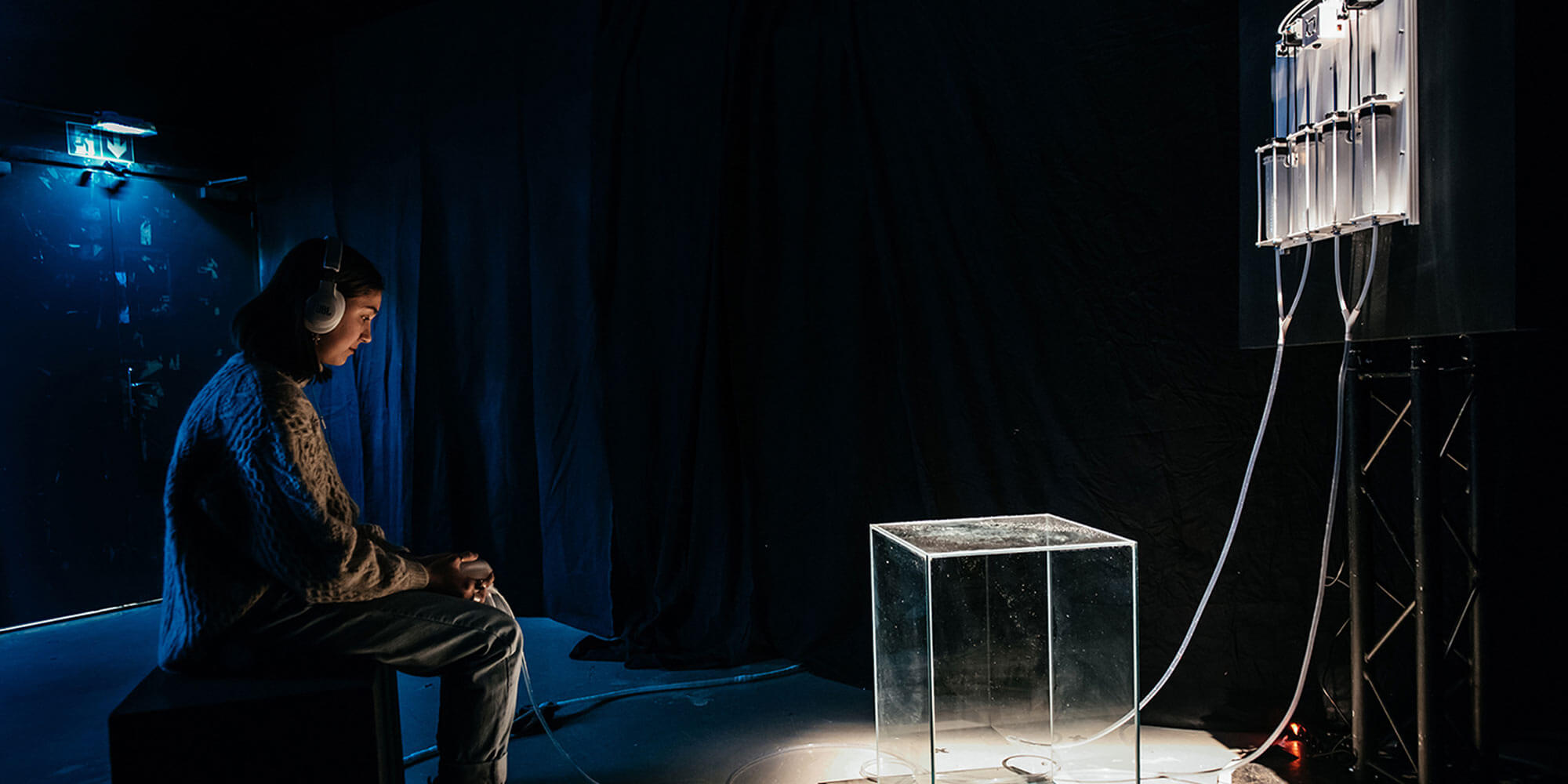
IAgotchi is a full entity, a new species. An artificial character who learns from our words. IAgotchi, artistic object derived of Tamagotchi, extends the questioning on the otherness. Without wanting to substitute the other one, what otherness, which place can we give to this other nature that is the machine, the artificial intelligence? Which relation can we build not from equal to equal, but to different to different, in the integration of the diversity. What can human still learn from his creations? IAgotchi is also a tool to dialogue with an art/work by an artificial intelligence. Created to favor the emergence and the evolution of an unpublished poetic material. It uses new strategies of interactive dramaturgy.
Rocio Berenguer is interested in the major challenges and changes of our contemporary world – including the evolution of spaces of individual freedom within our society, the place of technology in our daily lives, environmental issues. Whether in Homeostasis#V2, focusing on the dialogue between human and artificial intelligence, in Ergonomics, inspired by the world of start-ups or in G5, about the threats to the future of humanity and species diversity, her creations are forward-looking fictions that explore the possibility of «another tomorrow». They also implicitly refer to our contemporary neuroses.
Atsushi Kobayashi (JP)
Germination
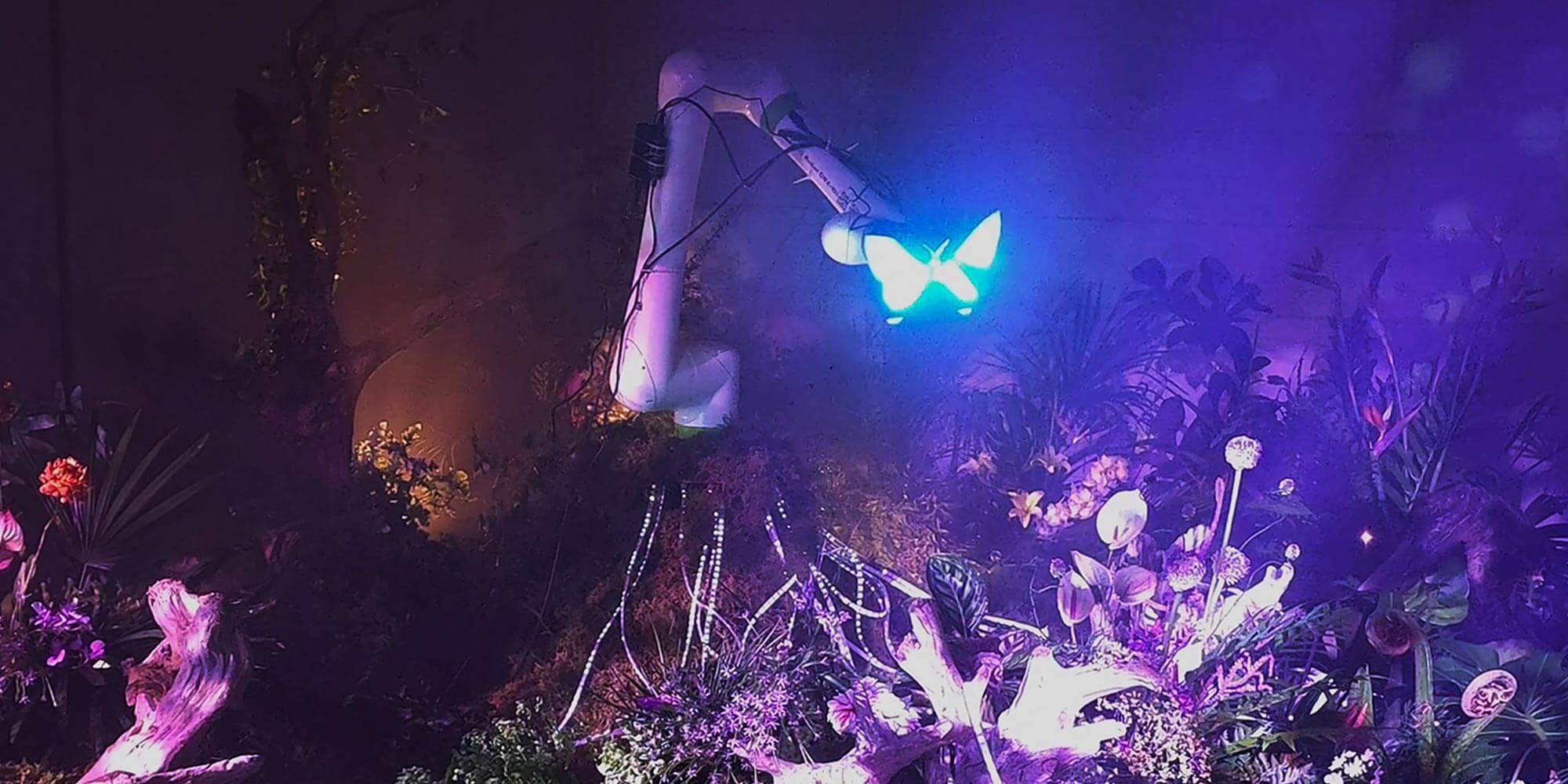
‘Germination’ was first exhibited in 2021, during the pandemic in Tokyo. The way a seed germinated, put down roots firmly in the ground, and sprouted vigorously on the surface of the earth overlapped with the way human beings restarted their daily lives after the pandemic. A robot arm was choreographed as a sprout which germinated from the ground after a period of dormancy and eventually bloomed again.
Atsushi is a creative technologist who unites sound, mechanical and visuals. He started his career as a graphic designer in TV Asahi in Tokyo. He also produced award-winning PR events as a creative director before he moved to Los Angeles in 2018 where he built a career as a creative technologist in a tech company “VT PRO DESIGN”. He worked for various clients like Google, Warner Bros. and Netflix. His skills span across designing, programming and fabricating.
Sahar Homami (IR/CA)
Fanaa
fanaa (فنا fanā) is a mystical concept, meaning „passing away“ or „annihilation“ (of the self): to die before one dies. This audiovisual journey interweaves elements of Persian calligraphy, mystical philosophy and generative art, entrancing into a poetic journey. In their artistic practice, Homami is committed to cinema as poetry and poetry as cinema. The visuals interweave elements of Persian calligraphy and generative art based on natural phenomena. The musical dramaturgy leads the audience through a rapidly shifting landscape of tonal scenes. Haunting synthesizer patches hum in a space of ambiguity between lush vibrancy & asepsis. fanaa presents a score in which cinematic ambience, punctuated with chasmic deep bass, gives way to a multiverse of intense, atmospheric, and industrial-flavored minimal dark techno interludes that at times feels both organic & mechanical. fanaa is inspired by 12th century Persian-Sufi poet Attar’s book The Conference of the Birds. The story unfolds through four chapters of Arrival, Dissolution, Absolute Nothingness, and Rebirth. fanaa represents a breaking down of the individual ego and a recognition of the fundamental unity of all that exists within the individual self.
Sahar Homami (They/She) is an audiovisual artist/programmer, calligrapher and researcher from Tehran, based in Berlin and Montreal (DE/CA/IR). Homami is invested in exploring altered states of consciousness through music and image. They strive to push the boundaries of perception and consciousness to expand our art of seeing, which spans knowledge, art, ethos and politics. Homami’s art practice is deeply influenced by classical Persian literature and mystical thought-systems. Their work has been presented at international festivals and conferences including MUTEK, INSCAPE, STEREOLUX, MULTIPLICA, HELLEARU, Tehran Contemporary Sounds, Berlin Music Video Awards amongst others.
Shift + Space Design & Research: Aya Riad – Joumana Abdelkhalek – Basant Elshimy – Reem Shahin (AE/EG)
BIO2DXB

BIO2DXB offers visitors a unique interactive design experience and a glimpse of a world of endless possibilities for a regenerative design future. BIO2DXB aims to demonstrate a model for the future of living that enhances the cultivation and use of local micro algae in the built environment. BIO2DXB acts as a large-scale bioreactor used as a medium for micro-algae cultivation. The installation emphasizes on the vast benefits of microalgae as they are responsible for 1/3 of the world’s carbon fixation and produce about 70% of the atmospheric oxygen. Microalgae can not only create clean renewable biofuels, but also remediate wastewater and create bio chemicals, pharmaceutical products, fertilizer, bio plastics and cosmetics. Using a modular, prototypical system of panels with a pattern inspired by Kufic Arabic script, the installation will be ever-changing in color and appearance during the event indicating the different stages, volumes, and densities in the lifecycle of the microalgae. It is estimated that 80% of energy consumption in the UAE is from the building industry. BIO2DXB aims to raise awareness on energy efficient and regenerative design that encourages the use of local micro-algae species in the future of the built environment of the UAE.
SHIFT + SPACE DESIGN & RESEARCH is a collective of design researchers and architects collaborating on experimental design positioned at the intersection of architecture, robotics, emergent technologies and art. Upon graduating from the renowned Architectural Association’s Design Research Lab (AADRL) in London, Aya Riad and Joumana Abdulkhalek co-founded Shift+Space with a shared vision to evolve the design process beyond the fixed architectural tendencies. They were later joined by likeminded AADRL graduate Basant Elshimy and Dubai-based architect Reem Shahin. The collective’s work dives into interactive, participatory design that begins from the person and expands to the surroundings. Advanced, computational design processes and cutting edge, digital fabrication tools are the main drivers to the collective’s architectural and interdisciplinary solutions. The collective’s mission is to revolutionize the architectural and design field to a brighter future from the UAE and the Arab region to the rest of the globe.
Amir Bastan
Vanishing Mediator
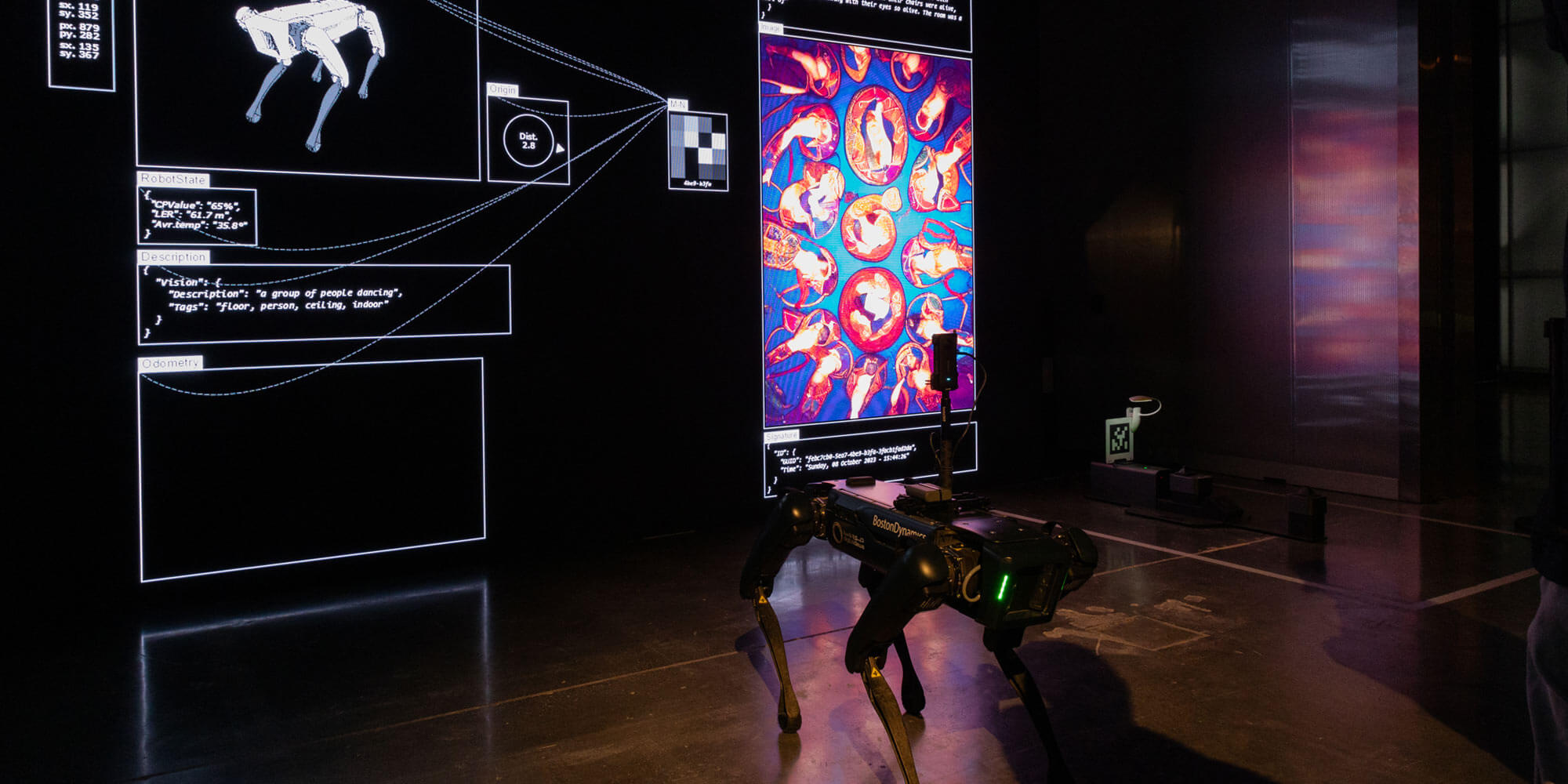
Remember, when you arrive there, at first, they place a mirror in front of you. They will suggest what you see in the mirror is a computer-generated image. You must believe them. Only then you’ll hear the truth! Behold the vanishing mediator, a robotic sprite that traverses the realm between two minds, in a dance with shadows, it weaves a tapestry of wonder, a storyteller of illusions, where truth and fantasy entwined.
As a new media artist with a background in fine arts and philosophy, Amir Bastan explores the gap between the conscious and the unconscious. He realizes his works by designing narratives through real-time processes. “The Human Robot Transference” is the centerpiece of his current research, drawing parallels between psychoanalysis theories and human-robot interaction within the context of new media arts. Alongside his artistic practice, Amir is developing “The Bunraku Project”, a software utilized for real-time control, visualization, and simulation of industrial robots. Amir is based in Linz/AT, where he is pursuing his PhD and is currently a researcher at Creative Robotics and a lecturer at the Art University in Linz.
